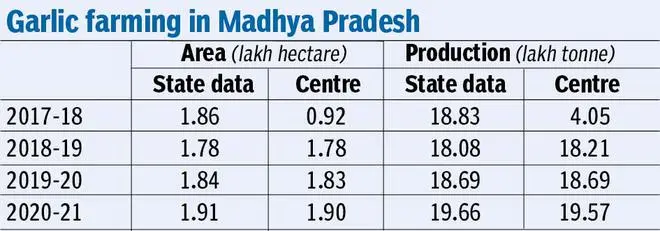Garlic output has nearly doubled in the last four years in India and increased close to five times in Madhya Pradesh, according to data placed by Union Agriculture Minister Narendra Singh Tomar in Parliament last week. However, it has been learnt that the Madhya Pradesh government has informed the Centre that there was no such increase and blamed the misunderstanding on likely “data error”.
In reply to a question from Lok Sabha MPs Gautham Sigamani Pon and CN Annadurai (both from DMK), Tomar, who incidentally hails from MP, said that Madhya Pradesh, Rajasthan, Uttar Pradesh, Gujarat, Punjab and Assam are leading garlic producing States, as per the third avanced estimates of 2020-21; he also placed the state-wise area and output data in the House.

“The error in area and production data of 2017-18 was communicated by the State government to National Horticulture Board much earlier and it is unfortunate that they have not corrected it,” said a source in the State government. For 2017-18, the State government estimated the garlic area at 1.86 lakh hectares while the Centre put it at 92,500 hectares. Similarly, production was 18.83 lakh tonnes, as per State data, whereas the Centre has put it at 4.05 lakh tonnes.
According to the State data, seven major districts — Dewas, Dhar, Indore, Mandsaur, Neemuch, Ratlam and Ujjain, each with more than 10,000 hectares under garlic — together produced 14.5 lakh tonnes in 2020, which is 73 per cent of the total output of Madhya Pradesh. While the output has increased from the 2017 level in each of them, only Neemuch (top producing district) faced a decline of 36 per cent due to a fall in area.
Import concerns
Over the last few years, import of garlic has been rising while export has been falling, barring some exceptions. Imports in the 2020-21 fiscal was at 7,473.40 tonnes (valued at ₹33.82 crore), the highest in 15 years. The previous high was 20,409.20 tonnes in 2004-05, official data show.
Exports of fresh and/or chilled garlic, on the other hand, after halving in 2014-15, began to rise and touched 23,547.25 tonnes in 2016-17, before declining again. Overseas shipments touched 4,497.93 tonnes during 2020-21, implying the country became a net importer that year. The country had a record 34,170.27 tonnes of exports in 2012-13.
“There is nothing wrong if both export and import continue simultaneously but the quantity matters; and for garlic, the country cannot afford to depend on others,” said an agriculture scientist. But AK Singh, deputy director general (horticulture) of Indian Council of Agriculture Research (ICAR), said there is much awareness about horticulture technologies among the new generation of farmers, who have been using drip irrigation in districts like Ratlam, Madhya Pradesh.
“The demand for high-value crops like garlic has gone up as more and more people are getting health-conscious. Farmers are shifting to garlic from crops like wheat and barley. Also, the net income realisation in garlic is higher compared to traditional crops,” Singh said.






Comments
Comments have to be in English, and in full sentences. They cannot be abusive or personal. Please abide by our community guidelines for posting your comments.
We have migrated to a new commenting platform. If you are already a registered user of TheHindu Businessline and logged in, you may continue to engage with our articles. If you do not have an account please register and login to post comments. Users can access their older comments by logging into their accounts on Vuukle.